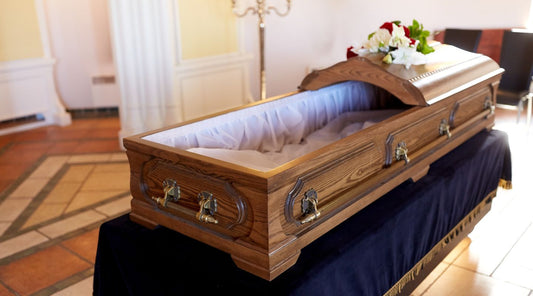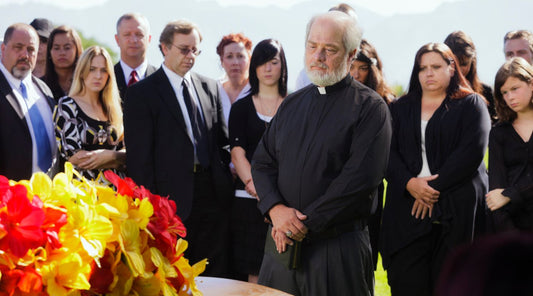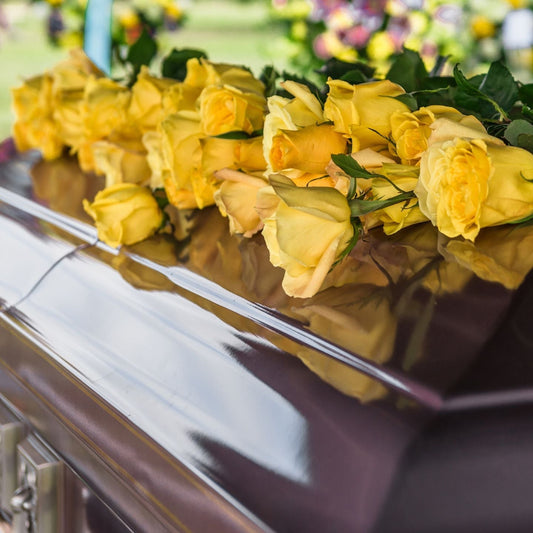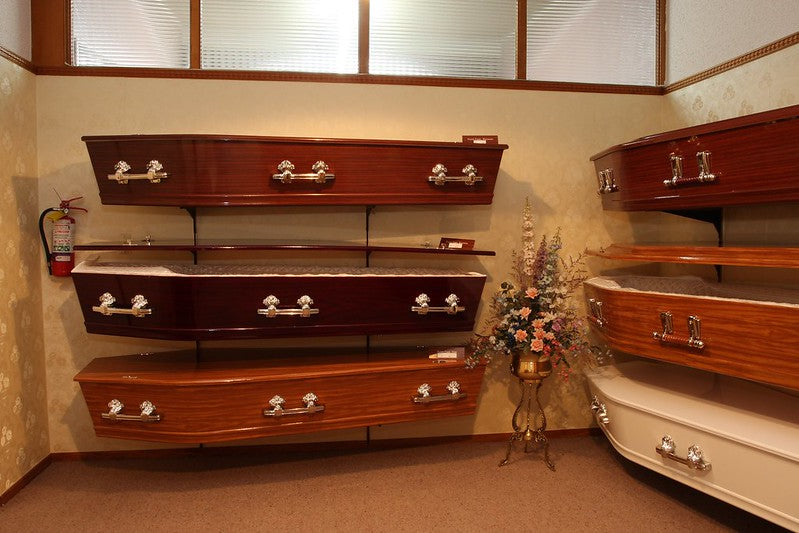
Why Do We Use Coffins?
Coffins and caskets are widely used in funeral services across the world. However, burial practices have seen constant evolution. While the history of the coffin dates back millennia, it wasn't until surprisingly recently that coffins and caskets became popular in the United States.
But why do we use coffins, and what are their benefits when we say our goodbyes? Discover their history and purposes with our guide.
What's the Difference Between a Coffin and a Casket?
Today, a coffin is distinguished from a casket by two main features:
- A coffin is usually hexagonal and widest at the shoulder area to reflect the human shape.
- A casket is rectangular, and half of it may be hinged for use in a funeral with an open casket to allow mourners to see the deceased.
Both are typically made from fine materials: wooden coffins and caskets are extremely popular, while metal is another common choice. We'll cover the reasons why caskets may be preferred for some services later on, but first, let's consider why coffins are used in burials.
Protecting the Body After Burial
There is evidence that a wooden coffin was used in Ancient China in the fascinating practice of hanging burials. Some of the oldest dates back around 3,500 years. This demonstrates our first significant reason a coffin is used: to protect the body after burial. While metal is more resilient to decay than wood, both materials provide a long-lasting barrier between the body and the ground.
The protection is often partly to separate the body from the ground. This allows the body to decay naturally without interference from earth-dwelling insects and bacteria. However, in Medieval Europe, coffins were widely used to deter scavengers and graverobbers.
If a body wasn't buried deeply enough, scavenger animals like foxes might dig into the ground to get to the body. This would be highly upsetting for loved ones visiting the grave, so in addition to burying the body at a safe depth, sturdy wooden coffins would prevent scavengers from getting to the body.
Wood was more affordable than metal at the time, so metal caskets and coffins were typically reserved for the nobility.
Graverobbing was an enduring issue in Europe even through to the 19th Century, as individuals were sometimes buried with their valuable possessions. More insidiously, medical students and doctors would pay for access to a fresh cadaver for their studies. Coffins, therefore, offered an extra layer of protection against this practice.

Transporting the Body
Coffins weren't widely used in the United States until the U.S. Civil War era. Soldiers who died in the war wished to be buried in their home region, and their loved ones would often arrange for the body to be transported home. For this to be done with dignity and minimal decay, the body needed to be protected from the elements. The parties moving the body needed to be protected from infectious diseases.
A wooden chamber allowed the safe transport of the body and meant that loved ones could bury their departed in peace. Modern-style caskets didn't become popular until later, when preservation methods like cooling and embalming would permit open casket funerals.
In some services in the U.S. and Europe, a coffin allows the deceased to be safely carried by pall-bearers before it is laid to rest. This is primarily considered a sign of respect in military funerals, when the coffin may also be covered by a flag representing the nation or regional identity of the deceased.
The flat surface also permits the coffin to be safely and respectfully lowered into a grave, with minimal disruption to the body. In some areas, it is traditional for a close relative or loved one to scatter the first earth on the lid before burial, which is made easier when the body is protected by its burial chamber.
Displaying the Body at Open Casket Funerals
Metal and wooden caskets are popular today they both allows to have a service with an open casket. This means that relatives and friends can say their goodbyes to the deceased in person. Caskets are usually made from fine materials and are often padded for this reason, as it shows a comfortable resting place.
Caskets tend to be rectangular and most of the caskets have two casket lids, the upper half can be opened, showing only the face and torso of the deceased and helping them to appear at rest, as if in bed. The hexagonal design of a coffin makes this impractical, which is why caskets are more common for open ceremonies.

Making a Peaceful Home for the Deceased When Laid to Rest
All burials eventually lead to the body returning to the Earth. Still, for many people, it brings comfort for the deceased to be given a private, protected resting space before this happens. Wooden coffins are usually made from types of wood that resist decay, while a metal coffin may last hundreds of years.
Just as open caskets are typically lined with fabric to help mourners understand that the deceased is comfortable in rest, a coffin may have a soft lining for the same reason. Internal padding also helps provide a soundproof cushion. This means that, for example, if the coffin is carried by pallbearers and sways slightly, so soft padding inside of the coffin prevents movement of the body inside of the coffin.
Protecting Staff at Funeral Homes from Disease
Funeral home staff work in highly hygienic conditions, as working with the recently passed can carry many health risks. While caskets aren't fully airtight, they offer an extra layer of protection for staff at funeral homes and anyone involved in performing the last rites.
This is especially important in the case of death due to an infectious illness. Keeping the body at a low temperature and procedures like embalming can dramatically slow the rate of decomposition, which protects funeral home staff against bacteria that develop in the body after passing.
However, infectious illnesses may still be present, in which case a coffin can provide a critical barrier when the body is being prepared for burial or cremation.

Protecting Against Early Decay
In addition to controlled circumstances like temperature, a coffin helps to isolate the departed from its surrounding environment. This creates a more sterile atmosphere to slow the rate of decay and decomposition.
This is important in all services. As mentioned, most of the caskets are not airtight, and advanced decomposition will lead to unpleasant smells even in a closed service. However, it is especially important for funerals with open caskets, as all measures must be taken to ensure that loved ones can say their farewells before decomposition begins.
Using Coffins for Cremations
Just as it is advantageous for pall-bearers or for transporting a body, cremations require the departed to be resting on a flat surface. Therefore, a coffin or casket is vital for the body to enter the crematorium easily and with dignity.
Wooden models are always used for cremation, as metal would not disintegrate in the crematorium. This method is increasingly popular in the United States and is often chosen over burial as it has a lesser environmental impact in many cases.
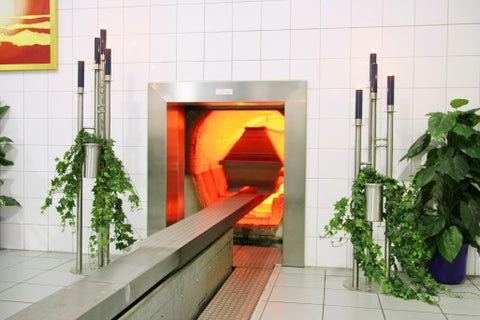
How We Choose Coffins for Our Loved Ones
There is no “right” choice. Families and loved ones tend to choose depending on factors including:
- Cultural or religious background
- To reflect the life of the departed, e.g. covering the coffin with a flag for a military service
- A decision based on the wishes of the deceased, where appropriate
- A chamber that protects the body and offers a comfortable place of rest
- An appropriate model for cremation, if this method is chosen
- To allow an open service
It's important to communicate closely with the knowledgeable representative of the casket company for expert advice and to understand the best choice for the deceased.
Preserving a Memory
The most important part of saying our goodbyes is feeling at peace that our loved one has been laid properly to rest. For many of us, coffins and caskets are an integral part of finding that peace. That's why the practice has survived for thousands of years and is still popular today.
Blog Author: Tim
